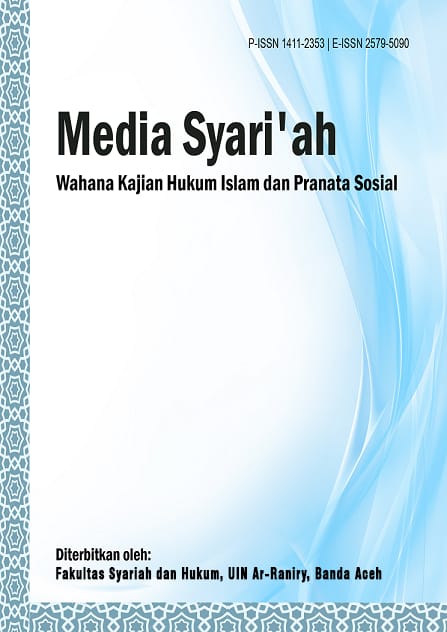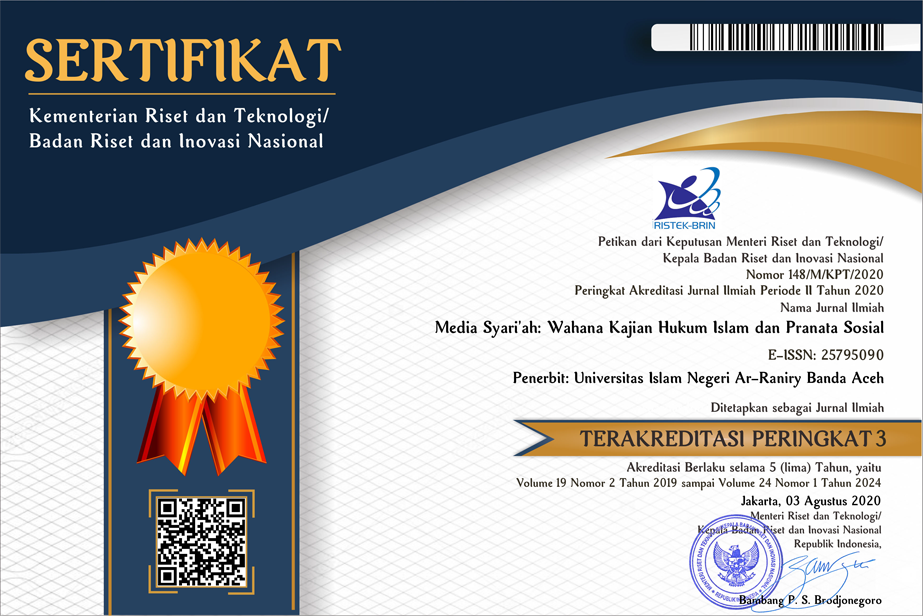Qath'i dan Zhanni dalam Kewarisan Islam
DOI:
https://doi.org/10.22373/jms.v22i2.7851Keywords:
Qath’y, Zhanny, Islam HeritageAbstract
Abstract
Qath'i and zhanni in Usul fiqh are useful to explain the source text of Islāmic law, both the Qur'an and the hadith in two ways, namely al-tsubut (existence) or al-wurud (coming of the truth of the source) and al-dalalah (interpretation). In the context of qath'i and zhanny al-wurud the scholars agree that al-Qur'an and muthatith hadith are qath’y.. But they differ in terms of qath'i and zhanni from al-dalalah's side. The ulama of ushul fiqh states that there are religious texts that only contain one clear meaning and cannot debate other interpretations, also contain certain numbers, so the text is considered as a qath'i al-dalalah text. While contemporary scholars argue that the concept of qath'i and zhanni While contemporary scholars argue that the concept of qath'i and zhanni al-dalalah both the Qur'an and Hadith cannot be seen from the meaning of lafaz alone but also on the desired essence of the lafaz. Thus, the result is that religious texts in the field of inheritance law are open to modern interpretations. Islāmic inheritance include in the Zhanni al-dalalah group because relates to human relations and socio-economic roles, also, historically the verses on inheritance contain the essential meaning of justice.
Abstrak
Qath’i dan zhanni dalam Ushul fiqh digunakan untuk menjelaskan teks sumber hukum Islam, baik itu al-Qur’an maupun hadits dalam dua hal, yaitu al-tsubut (eksistensi) atau al-wurud (kedatangan kebenaran sumber) dan al-dalalah (interpretasi). Dalam konteks qath’i dan zhanny al-wurud para ulama sepakat bahwa al-Qur’an dan hadits mutawatir adalah qath’i Namun mereka berbeda pendapat dalam hal qath’i dan zhanny dari sisi al-dalalah. Ulama ushul fiqh menyatakan bahwa jika suatu teks keagamaan hanya mengandung satu makna yang jelas dan tidak bisa membuka kemungkinan interpretasi lain, serta menyebutkan bilangan tertentu, maka teks tersebut dianggap sebagai teks yang qath’i dari sisi al-dalalah. Sementara ulama kontemporer berpendapat bahwa konsep qath’i dan zhanni al-dalalah baik al-Qur’an maupun Hadits tidak bisa dilihat dari kejelasan makna lafaz saja tetapi juga pada esensi yang diinginkan dari lafaz tersebut. Dengan demikian konsekuensinya adalah teks-teks keagamaan di bidang hukum waris terbuka terhadap penafsiran modern. Kewarisan islam masuk dalam kategori zhanny al-dalalah karena kaitannya dengan hubungan antar manusia dan peran sosial ekonomi, selain itu jika dilihat secara historisnya ayat-ayat mengenai kewarisan mengandung makna yang esensi yaitu keadilan.
References
Al-Robin. (2018). Problematika Hukum Pembagian Waris 2:1 dalam Pendekatan Teori Qath’i Zhanni. Sangaji, 2(1).
Al-Zuhaili, W. (2001). Ushul Fikih al-Islami. Dar al-Fikr.
An-Na’im, A. A. (1994). Dekonstruksi Syari’ah. LKIS Yogyakarta.
As-Suyuti, J. (2013). Lubabun Nuquul Fii Asbaabin Nuzuul. Gema Insani.
Bahri, S. (2008). Metodologi Hukum Islam. Teras.
Haika, R. (2016). Konsep Qath’i Zhanni dalam Hukum Kewarisan Islam. XV(2), 183–195.
Haries, H. A. (2014). Gagasan Pembaruan dalam Bidang Hukum Kewarisan. Mazahib, 13(2).
Haroen, N. (1997). Ushul Fiqh. PT. Lagos Wacana Ilmu.
Kasdi, A. (2014). Maqasyid Syari’ah Perspektif Pemikiran Imam Syatibi dalam Kitab Al-Muwafaqat. Yudisia, 5(1), 46–63.
Khaeruman, B. (2010). Hukum Islam dalam Perubahan Sosial. CV. Pustaka Setia.
Khallaf, Abdul Wahab. (1990). Ilmu Ushul al-fiqh. Maktabah al-Dakwah.
Khallaf, Abdul Wahhab. (1996). Kaidah-kaidah Hukum Islam. PT. Raja Grafindo Persada.
Kholidah. (2016). Qathi’ dan Zhanni Menurut Masdar Farid Mas’udi. Fitrah, 02(1), 19–36.
Mas’udi, M. F. (1993). Agama Keadilan Risalah Zakat (Pajak) dalam Islam. Pustaka Firdaus.
Musa, M. Y. (1959). Al-Tirkah wa Al-Mirats fi Al-Islam. Dar al-Kitab.
Noorhaidi. (1996). Prinsip dan Teori-teori Hukum Islam (Cet.1). Pustaka Pelajar.
Sa’dan, S. (2017). Ijtihad terhadap Dalil Qath’i dalam Kajian Hukum Islam. Samarah, 1(2).
Sari, A. (2019). Qath’y dan Zhanni dalam Kewarisan Islam. Al-Muamalat, IV(02).
Shihab, M. Q. (1992). Membumikan al-Qur’an: Fungsi dan Peran Wahyu dalam Kehidupan Masyarakat. Penerbit Mizan.
Syaukani, I. (2006). Rekonstruksi Epistimologi Hukum Islam Indonesia. PT. Raja Grafindo Persada.
Thalib, S. H. A. (1990). Tatbi al-Syari’ah al-Islamiyah. Dar al-Nahdhah al-Arabiyah.
Zahrah, M. A. (1958). Ushul al-fiqh. Dar al-Fikr al-Arabi.
Downloads
Additional Files
Published
Issue
Section
License
MEDIA SYARI'AH: Wahana Kajian Hukum Islam dan Pranata Sosial has CC-BY-SA or an equivalent license as the optimal license for the publication, distribution, use, and reuse of scholarly work. Authors who publish with this journal agree to the following terms:
1. Authors retain copyright and grant the journal right of first publication with the work simultaneously licensed under a Creative Commons Attribution-ShareAlike 4.0 International License that allows others to share the work with an acknowledgment of the work's authorship and initial publication in this journal.
2. Authors are able to enter into separate, additional contractual arrangements for the non-exclusive distribution of the journal's published version of the work (e.g., post it to an institutional repository or publish it in a book), with an acknowledgment of its initial publication in this journal.
3. Authors are permitted and encouraged to post their work online (e.g., in institutional repositories or on their website) prior to and during the submission process, as it can lead to productive exchanges, as well as earlier and greater citation of published work (See The Effect of Open Access).
You are free to:
Share — copy and redistribute the material in any medium or format.
Adapt — remix, transform, and build upon the material for any purpose, even commercially.
The licensor cannot revoke these freedoms as long as you follow the license terms.
All papers published in MEDIA SYARI'AH: Wahana Kajian Hukum Islam dan Pranata Sosial are licensed under a Creative Commons Attribution-ShareAlike 4.0 International License.




.png)


.png)
.png)
.png)



